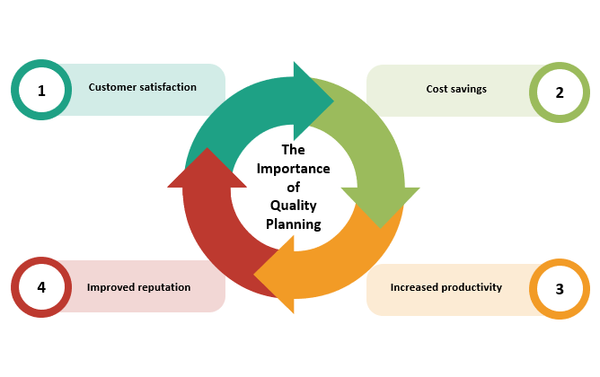What Is Quality Planning and Why It Is Important?
Quality planning is an essential process in any organization that helps to ensure that products and services meet the desired standards and expectations of the customers. Quality planning is the foundation upon which all quality management systems are built. It is establishing the necessary processes, resources, and activities needed to achieve the desired quality in products and services. Quality planning encompasses defining and establishing quality objectives, identifying quality control measures, and developing quality assurance strategies. Quality planning must be considered as it helps organizations minimize defects, reduce costs, increase customer satisfaction, and ensure compliance with applicable regulations and standards. This article will explore the importance of quality planning and how it can be implemented in organizations.

Defining Quality Planning
Quality planning involves identifying the quality needs, objectives, specifications, and standards for a project, product, or service and developing a plan to meet those needs. It requires thoroughly analyzing customer requirements, market trends, product attributes, and the organization's capabilities, resources, and processes.
Quality planning includes identifying potential risks and issues that can impact the quality of the product, determining the resources and activities needed to achieve the quality goals, and establishing a system for measuring and monitoring quality effectiveness. The plan should also identify the roles and responsibilities of individuals and teams involved in the quality process and define the processes and procedures for quality control and assurance.
The Importance of Quality Planning
Quality planning is crucial for the success of any organization, as it ensures that the products or services delivered meet customer expectations and requirements. Here are some reasons why quality planning is essential:
- Customer satisfaction: Providing quality products or services is essential to meet customer needs and expectations. Quality planning enables organizations to understand customers' needs and create products or services that meet them.
- Cost savings: Quality planning helps organizations identify defects and issues early in product development. This can save time and money as fixing issues earlier in the process is easier and less expensive than finding and fixing them after production.
- Increased productivity: Quality planning ensures that employees understand their roles and responsibilities and that processes are well-defined. This helps to reduce errors, eliminate waste and improve productivity.
- Improved reputation: Delivering quality products or services can enhance an organization's reputation and improve customer loyalty. This can lead to increased sales and profitability.
The Benefits of Quality Planning
- Improved Communication: Quality planning helps establish a common understanding of a project's quality metrics and standards. This, in turn, improves communication between team members and stakeholders and reduces the chances of misunderstandings or confusion.
- Better Resource Management: By defining quality standards and metrics, quality planning helps to ensure that resources are focused on meeting project goals and objectives. This leads to better resource management and helps to reduce wastage and unnecessary expenditure.
- Reduced Risks: Quality planning helps to identify potential risks and problems that could impact the success of a project. By planning, risks can be eliminated or minimized, which reduces the chances of costly delays, rework, or failures.
- Improved Efficiency: Quality planning sets clear goals and objectives, which helps to streamline project activities and make them more efficient. This improves overall productivity and helps ensure the project is completed on time and within budget.
The Process of Quality Planning
- Define the project goals and objectives: The first step in quality planning is to define the project goals and objectives. This will help you determine what level of quality is required and what your quality standards should be.
- Identify the stakeholders: The next step is identifying the stakeholders affected by the project’s quality. This may include customers, employees, suppliers, and other interested parties.
- Determine the quality standards: Once you have defined the project goals and stakeholders, you can determine the quality standards that must be met. Quality standards should be set based on the project’s scope, requirements, and expectations.
- Create a quality management plan: A quality management plan outlines the processes that will be used to meet the quality standards. It should include quality control, quality assurance, and quality improvement processes.
- Assign responsibilities: Each person involved in the project should be assigned specific responsibilities for quality management. This includes project managers, quality assurance staff, and team members.
Tools and Techniques For Quality Planning
- Quality checklists: These are detailed lists of criteria that you want your product, service, or process to meet.
- Flowcharts: Flowcharts can help you understand how a process works and identify areas for improvement.
- SWOT analysis: This is a technique used to identify an organization's strengths, weaknesses, opportunities, and threats.
- Brainstorming: This process involves generating ideas to solve a specific problem or improve a specific process.
- Root cause analysis: This method identifies the underlying causes of a problem or issue.

Implementation and Continuous Improvement in Quality Planning
- Set clear quality objectives: Organizations should establish clear quality objectives that align with their overall business objectives and communicate them to all relevant stakeholders. These objectives should be specific, measurable, attainable, relevant, and time-bound (SMART) and regularly reviewed and updated.
- Establish quality standards and procedures: Organizations should develop and implement quality standards and procedures that outline the requirements for product and service quality and the steps to achieve and maintain them. These should be documented, communicated, and regularly reviewed to ensure effectiveness.
- Train personnel: Employees play a critical role in ensuring quality; thus, organizations should invest in training and development programs for their personnel. This should include ongoing training to ensure employees are aware of changes in quality standards and can implement new quality processes effectively.
- Conduct continuous improvement initiatives: Organizations should continuously review and analyze quality metrics to identify areas for improvement and take corrective actions. This can involve implementing quality improvement tools such as Lean Six Sigma, Kaizen, and Total Quality Management.
Conclusion
Quality planning refers to identifying the quality standards and requirements for a particular project or product and developing a plan to ensure those standards are met. It is an essential aspect of any project or business operation and is crucial in ensuring that the final product or service meets the customer's expectations. Quality planning involves various activities, including defining quality objectives, identifying quality standards, determining the resources required, and establishing processes and procedures for quality control and assurance. This process is critical as it helps to ensure that the project or product is completed within the given time frame and budget while meeting the highest quality standards. This article will explore the importance of quality planning in more detail and discuss its benefits and key components.




